What is a clown?
According to the Encyclopedia Britannica, a clown is "a familiar
comic character of pantomime and circus, known by his (sic) distinctive
makeup and costume, ludicrous antics, and buffoonery, whose purpose is
to induce hearty laughter. The clown, unlike the traditional fool or
court jester, usually performs a set routine characterized by broad,
graphic humor, absurd situations, and vigorous physical action".
A brief
history of clowning
Some of the earliest ancestors of the clown were present in ancient
Greece. These comics were bald-headed and padded to appear larger than
normal. They performed as secondary figures in farces and mime parodying
the actions of more serious characters and at times threw nuts at the
spectators. A similar type of clown also was present in the Roman mime.
This clown wore a pointed hat and a patchwork colorful robe and was the
target for all the tricks and abuse of his fellow actors.
In the late Middle Ages, the clown emerged as a professional comic
actor when traveling entertainers began to imitate the antics of the
court jesters and the amateur fool societies. The traveling companies of
the Italian commedia dell'arte developed one of the most famous and
durable clowns of all time, the Arlecchino, or Harlequin some time in
the latter half of the 16th century. The Harlequin began as a comic
valet, or "zany," but soon developed into an acrobatic trickster,
wearing a black domino mask and carrying a bat or noisy slapstick with
which he frequently spanked his victims.
The English clown was descended from the Vice character of the
medieval mystery plays, a buffoon and prankster who could sometimes
deceive even the Devil. Among the first professional stage clowns were
the famous William Kempe and Robert Armin, both whom were connected with
Shakespeare's company. Traveling English actors of the 17th century were
responsible for the introduction of stage clowns to Germany, among them
such popular characters as Pickelherring, who remained a German favorite
until the 19th century. Pickelherring and his confederates wore clown
costumes that have hardly changed to this day: oversized shoes,
waistcoats, and hats, with giant ruffs around their necks.
The traditional whiteface makeup of the clown is thought to be
introduced by the character of Pierrot, the French clown with a bald
head and flour-whitened face. He first appeared during the latter part
of the 17th century. He was created as a fool for Harlequin, Pierrot was
gradually softened and sentimentalized. The pantomimist Jean-
Baptiste-Gaspard Deburau took on the character in the early 19th century
and created a famous love-sick, pathetic clown, whose melancholy has
since remained part of the clown tradition.
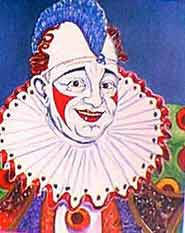 The earliest of the true circus clowns was Joseph Grimaldi, who first
appeared in England in 1805. Grimaldi's clown, called "Joey,"
specialized in the classic physical tricks, tumbling, pratfalls, and
slapstick beatings. In the 1860s a low-comedy comic appeared under the
name of Auguste, who had a big nose, baggy clothes, large shoes, and
untidy manners. He worked with a whiteface clown and always spoiled the
latter's trick by appearing at the wrong time to mess things up. The earliest of the true circus clowns was Joseph Grimaldi, who first
appeared in England in 1805. Grimaldi's clown, called "Joey,"
specialized in the classic physical tricks, tumbling, pratfalls, and
slapstick beatings. In the 1860s a low-comedy comic appeared under the
name of Auguste, who had a big nose, baggy clothes, large shoes, and
untidy manners. He worked with a whiteface clown and always spoiled the
latter's trick by appearing at the wrong time to mess things up.
Grock (Adrien Wettach), a famous whiteface panomimist, evoked
laughter in his continual struggle with inanimate objects. Chairs
collapsed beneath him. When a stool was too far from a piano, he shoved
the piano to the stool. His elaborate melancholy resembled that of
Emmett Kelly, the American vagabond clown.
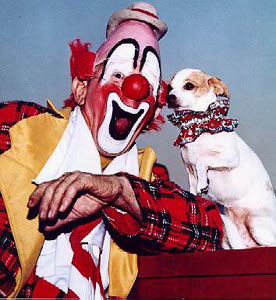
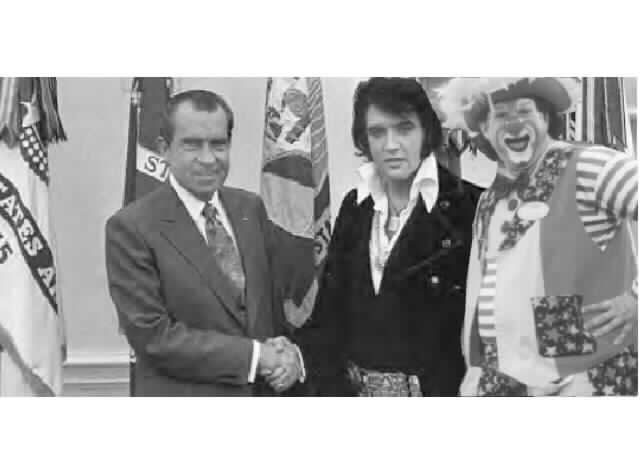
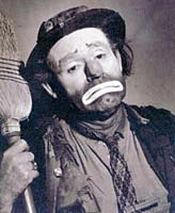 |




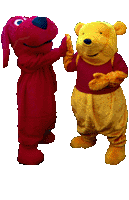
 The earliest of the true circus clowns was Joseph Grimaldi, who first
appeared in England in 1805. Grimaldi's clown, called "Joey,"
specialized in the classic physical tricks, tumbling, pratfalls, and
slapstick beatings. In the 1860s a low-comedy comic appeared under the
name of Auguste, who had a big nose, baggy clothes, large shoes, and
untidy manners. He worked with a whiteface clown and always spoiled the
latter's trick by appearing at the wrong time to mess things up.
The earliest of the true circus clowns was Joseph Grimaldi, who first
appeared in England in 1805. Grimaldi's clown, called "Joey,"
specialized in the classic physical tricks, tumbling, pratfalls, and
slapstick beatings. In the 1860s a low-comedy comic appeared under the
name of Auguste, who had a big nose, baggy clothes, large shoes, and
untidy manners. He worked with a whiteface clown and always spoiled the
latter's trick by appearing at the wrong time to mess things up. 

